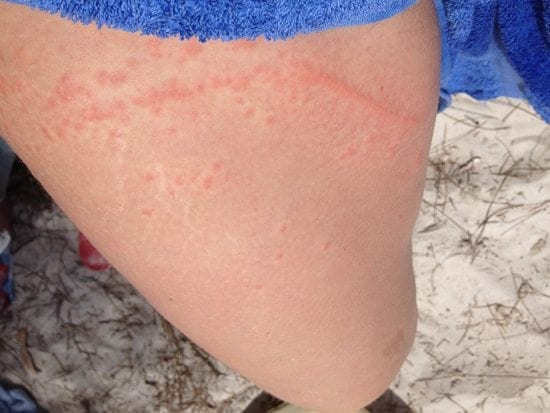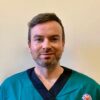Bluebottle Jellyfish
Bluebottle Jellyfish are not actually a single organism but are made up of zooids. These bluebottles cause thousands of stings each year on Australian beaches and hot water usually provides relief. Major systemic envenoming does not occur (unlike other Physalia stings in other parts of the world).
Resus
- Not life threatening
Risk Assessment
Typical symptoms include:
- Burning pain lasting up to two hours with linear and elliptical erythematous welts.
- Systemic symptoms can rarely occur including nausea, headache and malaise
Case 1


Case 2



Supportive Care
- Hot water Place affected area in a shower or a bowl of hot water – approx 45 degrees, should be hot but not scalding or uncomfortable for 20 minutes. Previously ice packs were used but hot water has shown superiority.
- Analgesia Simple analgesia such as paracetamol and ibuprofen.
- Vinegar has been known to worsen these stings.
Investigations
- Not required
Differential Diagnosis:
- Irukandji syndrome has delayed pain and is usually severe with systemic features. Skin markings or welts are usually not seen
- Box jellyfish have immediate severe pain and obvious dermal markings and tentacles may still be adhered to the skin
Antivenom
- Not available
Disposition
- As a general rule patients do not usually require a hospital admission unless pain is an issue.
References
- Tox Library – Blue Bottle Jellyfish
- Loten C, Stokes B, Wortley D et al. A randomised controlled trial of hot water (45ºC) immersion versus ice packs for pain relief in bluebottle stings. Medical Journal of Australia 2006; 184(7):329-333
- Tibballs J. Australian venomous jellyfish, envenomation syndromes, toxins and therapy. Toxicon. 2006 Dec 1;48(7):830-59.

Toxicology Library
TOXINS
Dr Conor O'Reilly, MB BCh BAO BComm, University College Dublin / Dublin City University, Ireland. In Australia working in Emergency Medicine with an interest in Sports medicine
Dr Neil Long BMBS FACEM FRCEM FRCPC. Emergency Physician at Kelowna hospital, British Columbia. Loves the misery of alpine climbing and working in austere environments (namely tertiary trauma centres). Supporter of FOAMed, lifelong education and trying to find that elusive peak performance.

